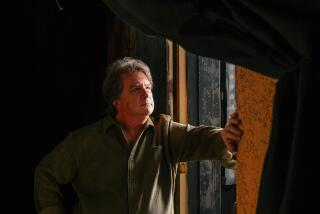Learning Show-Biz From a Pro
“I pack two complete bags in the morning: one my teaching bag, one my show-biz bag,” says Alan Sacks, with a grin.
At 57, the Studio City man is happy to both teach media arts and practice them. When the last Emmys were handed out, Sacks won for children’s programming for a film on racism he produced for the Disney Channel. And he was recently made chair of the new Media Arts Academy at Valley College.
In some ways, Sacks is much like many of his students--someone who dreamed of a career in the entertainment business as a youngster with more ambition than money.
A native New Yorker, Sacks went to Brooklyn College, one of the fine, low-cost public colleges that have served generations of immigrant, poor and working-class youngsters, much as today’s community colleges do.
Sacks studied what was then a cutting-edge field--broadcasting. And, he recalls, it changed his life. More specifically, it helped him get an internship at ABC, which led to a job in programming. Soon, Sacks was supervising his own shows.
With ABC under his belt, Sacks became producer of “Chico and the Man,” one of the first TV series to feature a Latino protagonist. Chico was played by Freddie Prinze, who was of Puerto Rican and Hungarian descent--a “Hungarican,” he called himself.
Troubled and charismatic, Prinze, who committed suicide in 1977, was a player in Sacks’ first big success. One night Prinze took Sacks with him to the Comedy Store, where they caught Gabe Kaplan’s stand-up act. Kaplan’s musings about his raucous Brooklyn high school struck Sacks as perfect material for a TV series.
With Kaplan, Sacks developed the idea for a show about a streetwise former student who returns to his alma mater to teach a multicultural class of “sweathogs.” They cast a winning young actor named John Travolta to play student Vinnie Barbarino (“There was a kid named Barbarino on 76th Street,” Sacks recalls) and pitched the project to Michael Eisner, then at ABC.
“It became an instant hit,” Sacks says of “Welcome Back, Kotter,” amazed at the continuing interest in a show that went off the air in 1979, after a four-year run.
“But that’s the past,” says Sacks, eager to talk about the projects he is working on today.
Important among them is the Media Arts Academy, which combines Valley College’s offerings in film, broadcasting and new media to help prepare students for careers in entertainment. The Media Arts Academy is neither as prestigious nor as exclusive as similar programs at USC and UCLA, but it is taught by professionals like Sacks, who has created, produced and written dozens of TV projects and films. And it is a steal at $11 a credit.
“We create a gateway to the industry for students who can’t afford USC, Hollywood Film School or AFI [the American Film Institute],” he says.
Emmy-Winning Film Based on True Story
Sacks’ recent Emmy is the sort of industry recognition that gives the Valley program credibility. Called “The Color of Friendship,” his Emmy-winning film was based on a true story. It recounts the experience of African American Rep. Ron Dellums and his family, who in 1977 invited an African student into their home. When she got off the plane, they discovered she was not black, as they had expected, but the white daughter of a South African policeman whose job included enforcing apartheid.
At Valley College this school year, Sacks’ students have been participating in a unique course called Media, Mind and Society. Using the school’s state-of-the-art videoconferencing facility, he is teaching the course with Derrick de Kerckhove, director of the McLuhan Program at the University of Toronto--named for Marshall McLuhan, who declared that the medium is the message.
Joining with De Kerckhove and his Toronto graduate students in a single virtual classroom, Sacks and his students in the Valley are exploring how new technology is shaping the entertainment industry and indeed the world. Guest lecturers sometimes join them from other locations.
Sacks remembers one occasion when the discussion included experts in San Francisco and Boston. “We were in four different cities conducting the class and it was completely seamless,” Sacks says, thrilled to be using new media to explore its implications.
Contacted in Toronto, De Kerckhove is equally pleased with the innovative course. “It feels like we’re there,” says De Kerckhove. Describing Sacks as a genial colleague, De Kerckhove says that Sacks’ experience as a Hollywood-based professional and his large network of industry contacts are a real plus for the Canadian students, who have little local exposure to the industry. De Kerckhove also praises the virtual collaboration for its economy (the savings in air fare alone is considerable). “It’s a great medium that should be used much more,” De Kerckhove says.
Planning to Pitch a New Project
Sacks believes such technology-facilitated collaborations are “the future of distance learning” and that he and his Valley students are fortunate to be in the vanguard.
“I have to keep reminding myself and my students that we can’t take this for granted,” he says.
When he isn’t living out of his teaching bag, Sacks is reaching into his show-biz bag. On a recent afternoon, he was planning to pitch a new project on an arcade-game subculture in Los Angeles to industry executives. Instead of making a poster-board presentation, as he might have done in the past, Sacks had shot and edited video of the gamers, which he would show the execs on his portable Sony Watchman.
Sacks says he has an inner teenager who throws himself into new projects with obsessive ardor. When he was doing a film on cowboy poets, he even dressed the part. “I have a collection of cowboy boots that are sitting there, collecting dust,” he confesses. And when he made a movie on skateboarding, he took up the sport. He still has the aching back to prove it.
For his new project, Sacks is immersing himself in the music of groups such as Insane Clown Posse that are favorites of the mostly Asian arcade-goers who currently fascinate him.
“When I develop a character, I think: ‘What music would they listen to?’ ” To find out what a subculture is really about, Sacks says, “music is always the way.”
*
Spotlight runs every Friday. Patricia Ward Biederman can be reached at valley.news@latimes.com.
More to Read
The complete guide to home viewing
Get Screen Gab for everything about the TV shows and streaming movies everyone’s talking about.
You may occasionally receive promotional content from the Los Angeles Times.






